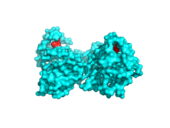Difference between revisions of "Fabry:Normal mode analysis"
Rackersederj (talk | contribs) |
Rackersederj (talk | contribs) (→Atomic Displacement Analysis) |
||
| Line 123: | Line 123: | ||
<figure id="fig:atomDisplacement3HG3"> |
<figure id="fig:atomDisplacement3HG3"> |
||
[[File:FABRY_atomDisplacement3HG3.png|300px|thumb|left|<caption>...</caption>]] |
[[File:FABRY_atomDisplacement3HG3.png|300px|thumb|left|<caption>...</caption>]] |
||
| + | </figure> |
||
| + | </div> |
||
| + | <div style="float: right"> |
||
| + | <figure id="fig:fluctuation_3HG2"> |
||
| + | [[File:FABRY_fluctuation3HG2.png|300px|thumb|left|<caption>...</caption>]] |
||
| + | </figure> |
||
| + | <figure id="fig:fluctuation_3HG2"> |
||
| + | [[File:FABRY_fluctuation3HG3.png|300px|thumb|left|<caption>...</caption>]] |
||
</figure> |
</figure> |
||
</div> |
</div> |
||
Revision as of 12:29, 9 July 2012
Fabry Disease » Normal_mode_analysis
Contents
Introduction
Maybe one of the first questions that can be asked in this task is, why we use low-frequency normal modes. This is explained in the paper of Marc Delarue and Philippe Dumas<ref>Marc Delarue and Philippe Dumas On the use of low-frequency normal modes to enforce collective movements in refining macromolecular structural models, Proc. Natl. Acad. Sci. (USA), 101, 6957-6962 (2004)</ref>, where they claim, that "many of the structural transitions (...) can be explained by just a few of the lowest-frequency normal modes". The normal modes can be used to generate the general motion of a system by superposition them. Thus we could in principle infer from our analysis in this task how the alpha-galactosidase A, which we examine hydrolyses the terminal alpha-galactosyl moiety of its substrate<ref>Normal mode http://en.wikipedia.org/wiki/Normal_mode, July 5th, 2012</ref>.
WEBnm@
WEBnm@ <ref>Hollup SM, Sælensminde G, Reuter N. WEBnm@: a web application for normal mode analysis of proteins BMC Bioinformatics. 2005 Mar 11;6(1):52 </ref> claim to administer simple and automated computation of low-frequency normal modes for proteins as well as their analysis in order to clarify if it is beneficial to perform a complete study on the protein in question.
The server calculates Normal Modes with the help of the MMTK package <ref>Hinsen K, The Molecular Modelling Toolkit: a new approach to molecular simulations, J Comput Chem, 21:79-85, 2000</ref>, which is an Open Source program library for molecular simulation applications. A C-alpha force field <ref>Hinsen K, Petrescu AJ, Dellerue S, Bellissent-Funel MC, Kneller GR, Harmonicity in slow protein dynamics, Chemical Physics, 261:25-37, 2000</ref> is used and only these C-alpha atoms are used, but with a weight assigned that corresponds to the masses of the whole residue they represent.
The server provides a bunch of analysis tools and all results can be downloaded without any problems. The tools are:
- deformation energies of each mode
- eigenvalues
- calculation of normalized squared atomic displacements
- calculation of normalized squared fluctuations
- interactive visualization of the modes using vector field representation or vibrations
- correlation matrix
<figtable id="tab:webnma_3hg2">
In this table are the 6 modes shown, that were calculated by WEBnm@. Depicted is the structure 3HG2, which represents the Human α-galactosidase catalytic mechanism with empty active site in cyan and the substrate binding site at position 203 to 207 highlighted in red.
</figtable>
<figtable id="tab:webnma_3hg3"> In this table are the 6 modes shown, that were calculated by WEBnm@. Depicted is the structure 3HG3, which represents the Human α-galactosidase catalytic mechanism with bound substrate (green, α-D-Galactose with bound α-D-Glucose) in cyan and the substrate binding site at position 203 to 207 highlighted in red.
</figtable>
Average Energies
<figtable id="tab:AverageEnergies"> ADD CAPTION HERE
| 3HG2 | 3HG3 |
|---|---|
| 406.07 | 318.52 |
| 580.11 | 508.88 |
| 1062.04 | 1078.20 |
| 1703.56 | 1621.95 |
| 1808.92 | 1827.08 |
| 2227.10 | 2019.97 |
| 2541.59 | 2481.89 |
| 3109.43 | 2695.35 |
| 3345.86 | 3321.12 |
| 3842.69 | 3588.18 |
| 4868.07 | 3782.94 |
| 5178.29 | 4404.61 |
| 6119.79 | 5349.94 |
| 5940.89 | 6027.59 |
</figtable>
Atomic Displacement Analysis
<figure id="fig:atomDisplacement3HG2">
</figure> <figure id="fig:atomDisplacement3HG3">
</figure>
Plots the displacement of each Calpha atom, i.e. highlights which parts of the protein are the most displaced for each mode.
ElNemo
References
<references/>
















